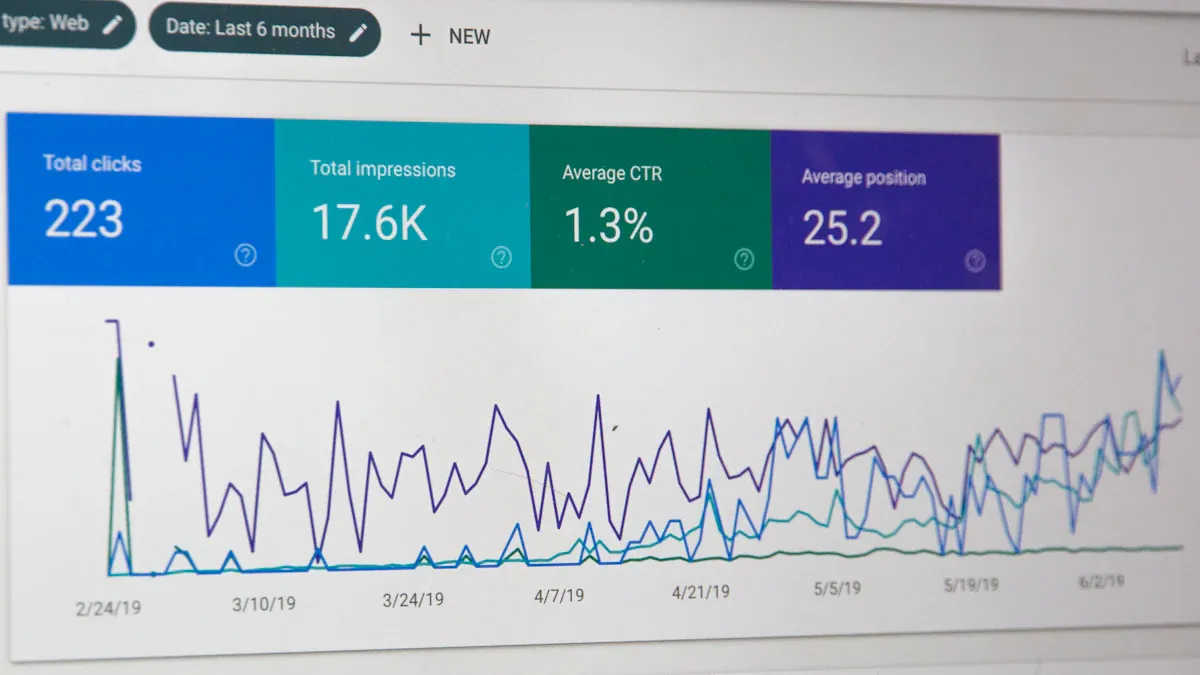
Google SEO refers to the strategies that help websites rank higher in search engine results. In today’s digital age, it plays a crucial role in enhancing online visibility. Statistics show that 68% of online experiences begin with a search engine. This highlights how vital it is for businesses to adapt their SEO strategies to stay competitive.
| Source | Percentage of Online Experiences Starting with a Search Engine |
|---|---|
| AIOSEO | 68% |
| ImForza | 93% |
Key Takeaways
- Understanding Google SEO is crucial for improving online visibility and driving business success.
- Regularly update your website content to signal activity to Google, enhancing indexing and rankings.
- Focus on high-quality content and optimize for voice search to meet evolving user preferences.
How Google SEO Works

Crawling
Crawling is the first step in how Google SEO operates. It involves Googlebot, a web crawler that systematically browses the internet to discover new and updated pages. Googlebot uses three main components to perform this task:
- Frontier: This is a list of URLs that Googlebot plans to visit.
- Fetcher: This component retrieves the content of web pages.
- Scheduler: It prioritizes which pages to crawl next.
Googlebot starts by visiting known websites and follows links within those pages to find new content. The frequency of crawling varies based on several factors, including the authority of the site, its popularity, and how often it updates its content. For instance, high-traffic websites may be crawled every couple of hours, while smaller sites might see less frequent visits.
Tip: To ensure effective crawling, website owners should avoid common challenges such as blocking crawlers with a robots.txt file or having complex URL structures that hinder navigation.
| Challenge | Description |
|---|---|
| Blocking of Crawlers by robots.txt | Websites can restrict crawlers from accessing certain pages using the robots.txt file. |
| Difficulty in Crawling JavaScript and Dynamic Content | Crawlers may struggle to index content generated dynamically through JavaScript. |
| Complex URL Structures for Search Engines | Complicated URL patterns can hinder the ability of crawlers to navigate a site effectively. |
Indexing
Once Googlebot crawls a website, the next step is indexing. This process involves storing and organizing the content found during crawling. Google uses specific criteria to determine which pages to index. Here are some key factors:
- Noindex Tags: Pages marked with ‘noindex’ will not be indexed.
- Broken Links and Redirects: Issues like broken links can prevent pages from being indexed.
- Duplicate Content: Duplicate content can confuse search engines, leading to potential non-indexing.
- SEO Best Practices: Applying SEO best practices enhances the chances of pages being indexed.
Regularly updating content signals to Google that a site is active, which can speed up indexing. Additionally, a website’s size can affect how quickly and completely Google indexes its pages. As noted, "The slower your pages load, the fewer of them Googlebot can crawl within your crawl budget."
Ranking
After indexing, Google evaluates how to rank pages in search results. The ranking process considers various factors, including:
- High-quality Content
- Backlinks
- Search Intent and Content Relevancy
- Website Loading Speed
- Mobile Friendliness
Among these factors, page speed has become increasingly important. In May 2021, Google made website loading speed part of its Core Web Vitals, emphasizing the need for fast-loading pages.
Google’s ranking algorithm also considers the meaning, relevance, quality, usability, and context of content. This comprehensive approach ensures that users receive the most relevant and valuable results for their queries.
Note: To improve rankings, website owners should focus on creating high-quality content and optimizing their sites for speed and mobile-friendliness.
Types of Google SEO
On-Page SEO
On-page SEO focuses on optimizing elements within a website to improve its visibility in search results. This includes creating high-quality content that targets specific keywords. Key techniques involve:
- Keyword Optimization: Strategically placing keywords in titles, headings, and throughout the content helps search engines understand page relevance.
- Meta Tags: Optimized meta tags can improve click-through rates, attracting more organic traffic.
- URL Structure: Descriptive URLs with relevant keywords enhance SEO performance.
By implementing these strategies, website owners can significantly boost their rankings in search results.
Off-Page SEO
Off-page SEO refers to actions taken outside of your website to influence rankings. This primarily involves building backlinks from other reputable sites. Backlinks act as endorsements, signaling to search engines that your content is valuable. Here are some effective off-page strategies:
- Guest Posting: Writing articles for other websites can help reach a wider audience and build backlinks.
- Social Media Marketing: Sharing content on social platforms can expand reach and potentially attract backlinks from high-authority sites.
Studies show that a significant percentage of web pages receive no organic traffic due to insufficient backlinks, highlighting their importance in enhancing search visibility.
Technical SEO
Technical SEO ensures that a website meets the technical requirements of search engines. This includes optimizing site speed, mobile-friendliness, and overall performance. Important factors include:
- Site Architecture: A logical structure aids in crawling and indexing, enhancing visibility.
- Page Speed: Fast-loading sites improve user experience and positively impact rankings.
- Secure Protocol (HTTPS): Using HTTPS enhances security and credibility, which can influence rankings.
By focusing on these aspects, website owners can create a better user experience and improve their search engine visibility.
Local SEO
Local SEO is crucial for businesses that serve specific geographic areas. It focuses on optimizing online presence to rank higher in local search results. Key strategies include:
- Google My Business Optimization: Keeping your business information up to date can significantly enhance local visibility.
- Customer Reviews: The quantity and sentiment of reviews influence local search performance.
By targeting local audiences effectively, businesses can attract more customers and improve their overall online presence.
Strategies to Improve Google SEO Rankings

Keyword Research
Keyword research forms the foundation of any successful SEO strategy. It helps identify the terms and phrases that potential customers use when searching for products or services. By targeting the right keywords, businesses can attract more relevant traffic. Here are some effective tools for keyword research in 2024:
- Moz Keyword Explorer: This tool offers a user-friendly interface and a proprietary Priority Score to help identify keyword opportunities. While it has limited free access, paid subscriptions unlock additional features.
- Semrush: Known for its user intent analysis, Semrush helps users understand their audience’s needs better.
Long-tail keywords play a significant role in this process. They attract motivated audiences and drive more organic traffic. In fact, over 70% of all search queries consist of long-tail terms, making them essential for effective SEO. Additionally, targeting long-tail keywords is generally easier than competing for broader terms, enhancing marketing efforts.
Content Optimization
Once you’ve identified your keywords, the next step is content optimization. This involves refining your website’s content to align with SEO best practices. Here are some key strategies:
- Each page should have a unique title that clearly indicates its content and includes at least one main keyword.
- Summaries should be concise and utilize strong keywords, as search engines often display this information in results.
- Properly structure headings using H1 for the page title and H2, H3 for subsections to organize content effectively.
- Incorporate relevant keywords naturally throughout the content, especially in headings and the first paragraph. Avoid keyword stuffing; instead, focus on using long-tail keywords that are specific and relevant.
Freshness also matters. Google’s algorithms consider content freshness when ranking pages. For time-sensitive queries, fresh content is prioritized. Regularly updating your content signals to Google that your site is active and relevant.
Link Building
Link building remains a crucial aspect of improving Google SEO rankings. Backlinks serve as endorsements from other websites, indicating that your content is valuable. Here are some effective link-building strategies:
- Commit to regular link building. Engaging consistently in this practice is essential for seeing meaningful results.
- Build links from relevant websites. Ensure that the sites you link from are pertinent to your content and have high domain authority.
- Create share-worthy content. Producing high-quality, engaging content encourages others to link back to your site.
Start with keyword research, use keywords in anchor text, leverage guest blogging, and consider influencer marketing to enhance your link-building efforts. Quality backlinks can significantly influence your website’s authority in Google’s eyes, leading to higher rankings for all content on your site.
User Experience
User experience (UX) plays a vital role in SEO performance. Search engines consider various UX factors when determining rankings. Here are some key elements that impact user experience:
| User Experience Factor | Description |
|---|---|
| Ease of Access | How easy it is to get to a web page |
| Quality of Visuals | The number of high-quality pictures and videos present |
| Content Load Speed | How quickly content appears on the page |
| Content Structure | The overall organization of your content |
| Click-Through Rate (CTR) | The percentage of users who click on your link |
| Bounce Rate | The percentage of visitors who leave after viewing one page |
| Dwell Time | How much time a user spends on your website or blog |
Improving these factors can lead to lower bounce rates and higher engagement. A slow-loading website frustrates users, leading to higher bounce rates and negatively impacting SEO. Positive user experiences increase engagement, which reduces bounce rates and enhances conversion likelihood.
Relevance of Traditional SEO Practices
Adapting to Emerging Technologies
As technology evolves, so does the landscape of SEO. Businesses must adapt to emerging trends like AI and voice search. A growing number of users prefer voice search for its convenience. This shift reshapes how search engines rank content. To stay competitive, companies should focus on conversational queries. For example, instead of targeting short phrases, they should optimize for longer, detailed questions like, "Where can I find a cheap pizza place open late near the city center?"
Additionally, local SEO has gained importance. Many voice searches are location-based, so businesses must ensure their Google My Business listings are accurate. Content should be conversational and provide direct answers to user questions. This aligns with how people naturally speak, making it easier for search engines to deliver relevant results.
Balancing Old and New Strategies
While adapting to new technologies is essential, traditional SEO practices remain effective. High-quality content continues to be a priority for Google. Backlinks from authoritative sites are crucial for SEO performance. Technical elements like optimized URLs and fast page loading speeds still matter. On-page SEO practices, including internal linking and keyword optimization, enhance visibility.
Moreover, maintaining a solid online presence is vital despite changes in SEO. Best practices include optimizing user experience through secure site design and high-quality content. Balancing these traditional methods with innovative strategies ensures businesses can navigate the ever-changing digital landscape effectively.
Understanding Google SEO is essential for anyone looking to thrive online. It shapes visibility and drives business success. To stay relevant, businesses must adapt continuously. Here are some key strategies to consider:
- Invest in high-quality, research-backed content.
- Optimize for voice search and mobile users.
- Regularly update your Google Business Profile.
By implementing these strategies, readers can improve their SEO results and enhance their online presence. 🌟
FAQ
What is the importance of keyword research in SEO?
Keyword research helps identify terms users search for, guiding content creation and improving website visibility in search results.
How often should I update my website content?
Regular updates signal to Google that your site is active, enhancing indexing and potentially improving rankings.
What role does user experience play in SEO?
User experience affects engagement and bounce rates. A positive experience can lead to higher rankings and better visibility in search results.